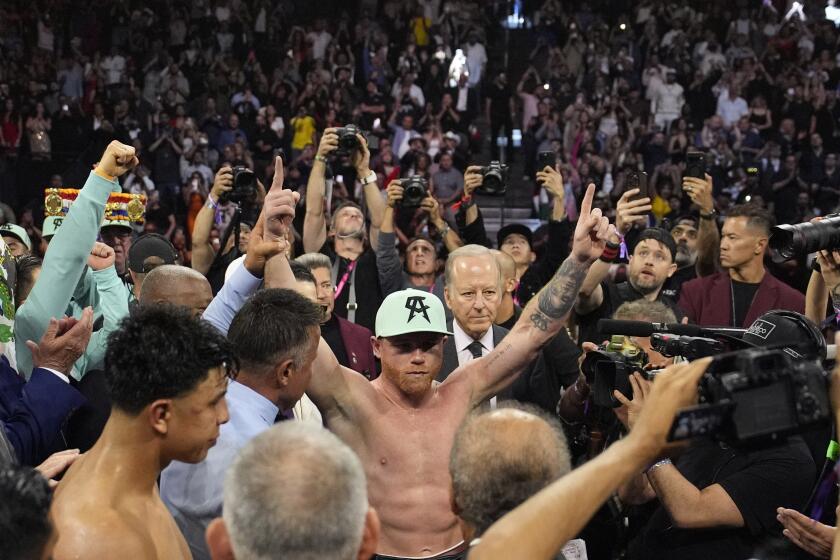Sacks on the Decline as Offenses Adjust to Big NFL Linebackers
The quarterback deftly drops back in the pocket, sees the strong safety cheating toward the line of scrimmage and automatically scans the right side for his tight end. Just as the arm is cocked to throw, the powerful outside linebacker breaks into the clear, closes quickly and ...
... The quarterback flips the ball easily to the tight end, who has only one defender to beat. It’s a 14-yard gain and the outside linebacker, two steps from gory glory, can only tap the quarterback on the shoulder pads in frustration.
The sack of the quarterback, perhaps the single most exciting play in football that doesn’t involve the end zone, is becoming an increasingly rare phenomenon. It isn’t in danger of becoming extinct, but if the recent trend continues, the sack may be headed for the endangered species list.
“In the old days,” says New York Giants linebacker Lawrence Taylor, referring to the early 1980s, “I could do anything I wanted. Now, they’ve got a million things that get in the way. They’re blocking with bigger guys and getting rid of the ball quicker. Now, it’s (difficult) getting to the quarterback.”
And it’s not just because Taylor has turned 30.
Sacks have dropped steadily since 1985. In the Year of the Bears, quarterbacks were decked 1,306 times. In 1986, the total was 1,198 and it dropped to 1,106 in 1987; even if the one game lost to the strike had been played, there would have been a substantial decline in sacks. Last season, quarterbacks were sacked 1,035 times.
This season, the total is 112 through two games, which projects to 896 sacks, or 32 per team. For comparison purposes, the Giants recorded 59 sacks in their championship season. The great sack artists, like Taylor, Buffalo’s Bruce Smith and Philadelphia’s Reggie White, will continue to reach the quarterback. Less talented athletes will encounter more resistance.
The common misconception, even among some of the league’s coaches, is that defenses aren’t blitzing as much. This doesn’t seem to be the case.
“I don’t think we’re blitzing any less,” says Fritz Shurmur, in his eighth season as the Los Angeles Rams’ defensive coordinator. “Actually, we’ve been in a more aggressive mode than in the last five years. We’re coming after people, but the sacks aren’t there. I think you have to look at the other side. Offenses are better prepared to handle the blitz.”
Let us count the ways:
When Taylor, an unprecedented 6-foot-3, 245-pound combination of size and speed, arrived in 1981, offenses didn’t know how to block him. Running backs, long the accepted solution to blitzing linebackers, weren’t enough. Tight ends didn’t work, either. Teams gradually learned to slide their offensive tackles toward Taylor.
“LT, Otis Wilson, Andre Tippett ... those guys were murdering the running backs who were trying to block them,” Giants defensive coordinator Bill Belichick says. “For a while there, quarterbacks were getting hit and coughing up the ball all the time. Now everybody’s got a big outside linebacker and everybody has bigger people to block them.”
In the 1960s and ‘70s, most quarterbacks took a conventional seven-step drop. That placed them a comfortable distance from the line of scrimmage and gave them time to read defenses and wait for receivers to come open. Today’s game is much faster.
“The quarterback can’t afford to sit back there any more,” says Floyd Peters, the Minnesota Vikings’ defensive coordinator. “They take that dinky three-step drop. Plus, the quarterback is throwing to a spot, even before the receiver breaks for the ball. That’s hard to defense.”
Another reason for declining sacks is the shotgun formation that most teams employ in long-yardage situations. “That was a big change,” Peters says. “If the guy is under center, you’ll go after him a lot more. When he’s back in the shotgun, you show blitz, then back off.”
Offenses also use the four-wide receiver set to reduce defenses’ tendency to blitz. Peters doesn’t like the increasingly wide-open game and calls it basketball on grass. Shurmur explains:
“Offenses are spreading it out. They go with four wide receivers and force you into a (man-to-man coverage) matchup you don’t like. When that happens, you’re a little leery. You keep guys in and back up with your free safety or strong safety.
“Now when you blitz, you know you’re going to get a hit on the quarterback, but you also know he’s probably going to get the ball there, too.”
Miami quarterback Dan Marino is the model when it comes to avoiding sacks. He has a lightning release, shrewd judgment and talented receivers. Against the New England Patriots last Sunday he went unsacked in his 14th consecutive game, an NFL record. That amounts to 563 pass attempts without a sack.
These factors, plus last year’s rule change that gave defenders more latitude when it came to incidental contact with receivers, has led to fewer pass rushers and more aggressive secondaries. “They’re attacking us in the secondary now,” says Ted Plumb, the Philadelphia Eagles’ offensive coordinator.
The result? Pass coverage has come full circle in the NFL, in a back-to-the-future kind of way.
The Tampa Bay Buccaneers won the NFC title in 1979 with a three-man pass rush and eight men in coverage. The defense allowed the fewest points, yards and passing yards that season, supporting an offense that scored only 17 points a game.
Offenses learned how to pick holes in zones with the extra time a limited rush allowed. Defenses were forced to adjust. By 1985, the Chicago Bears were sending seven and eight men after the quarterback. That was when sacks peaked.
Now, as offenses have reacted by adding larger blockers and more of them, defenses are going for a more subtle approach. They are willing to sacrifice a running back as a blocker if they can find one matchup they like against a man-to-man defense. As Chicago Coach Mike Ditka said, “You can get a big play if you block everybody and beat one guy.”
Defenses, in turn, spend more time trying to fool the quarterback than squash him. “There are different coverages, coverages I haven’t seen since I’ve been in the league,” Giants quarterback Phil Simms says. “Coverages that go back to the day of George Allen.”
As Peters says, “Everybody wants to buy that one mistake. The game still comes down to third down and you want to make the quarterback make the wrong choice, if you can. By disguising coverages you can do that. It’s the only real choice we have now.”
More to Read
Get our high school sports newsletter
Prep Rally is devoted to the SoCal high school sports experience, bringing you scores, stories and a behind-the-scenes look at what makes prep sports so popular.
You may occasionally receive promotional content from the Los Angeles Times.






